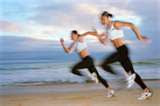 Janna's family came for support!
Janna's family came for support!Sunday, November 29, 2009
Friday, November 27, 2009
We Found the Perfect Running Bra
Good Advice
Here is a sample of a article I read on the Seattle Marathon website. It is worth reading.
Race Day Hydration: How Much is Enough?
CALCULATE YOUR INDIVIDUAL NEEDS
Sweat Rate:
Sweat rates are not uniform. They vary according to genetics, conditioning (what shape you are in), and the ambient environment (how hot or cold it is). They can range from very slow rates of sweat loss to losses up to 3 liters/hour when exercising in very hot conditions; thus, you need to calculate your own sweat rate in conditions that match the day of the race. To do this, just before a one-hour training run (preferably at marathon pace), weigh yourself unclothed. When you return from your run, disrobe, dry yourself off, and weigh yourself again. The weight difference is the amount of fluid lost. (Rapid weight loss is an indicator of fluid loss, not fat loss). If you lost one pound (16 ounces) during that one hour run, you thus need to drink 4 ounces every 15 minutes to replace your losses.
SUMMARY
Dehydration has well known effects on performance and health (slower speeds and increased risk of heat illness to name a few). Overhydration can have similar detrimental effects; thus, creating a race day hydration strategy is important. Fluid replacement schedules need to be individualized as global recommendations for fluid replacement may not be optimal for individual runners of differing body types and with varying degrees of training and heat acclimatization. Remember to create a race day hydration strategy and stick to it.
Race Day Hydration: How Much is Enough?
CALCULATE YOUR INDIVIDUAL NEEDS
Sweat Rate:
Sweat rates are not uniform. They vary according to genetics, conditioning (what shape you are in), and the ambient environment (how hot or cold it is). They can range from very slow rates of sweat loss to losses up to 3 liters/hour when exercising in very hot conditions; thus, you need to calculate your own sweat rate in conditions that match the day of the race. To do this, just before a one-hour training run (preferably at marathon pace), weigh yourself unclothed. When you return from your run, disrobe, dry yourself off, and weigh yourself again. The weight difference is the amount of fluid lost. (Rapid weight loss is an indicator of fluid loss, not fat loss). If you lost one pound (16 ounces) during that one hour run, you thus need to drink 4 ounces every 15 minutes to replace your losses.
SUMMARY
Dehydration has well known effects on performance and health (slower speeds and increased risk of heat illness to name a few). Overhydration can have similar detrimental effects; thus, creating a race day hydration strategy is important. Fluid replacement schedules need to be individualized as global recommendations for fluid replacement may not be optimal for individual runners of differing body types and with varying degrees of training and heat acclimatization. Remember to create a race day hydration strategy and stick to it.
Tuesday, November 24, 2009
Fall Running by Jeff Galloway RW
From the October 2009 issue of Runner's World
Many people fall in love with running at this time of year. And it's no wonder, thanks to cooler temps, pretty views, and the camaraderie of friends getting ready for races. Here's how to take your fitness up a notch during this perfect season.
ADD 10 MINUTES Even if you typically head out in the wee hours, a 10-minute sleep loss won't hurt. Start at a slower pace to ensure a good warmup. The increased distance will burn more fat and ramp up your fitness.
PICK UP THE PACE Once a week, after a five-to 10-minute warmup, run slightly faster for five to 10 steps, then jog slowly for 10 steps. Repeat this five times, running slightly faster each time. Take a two-to three-minute walk break. Then do five 90-second drills: walk for 30 seconds, jog for 30 seconds, run faster for 30 seconds—then repeat. Add one or two additional 90-second drills each week.
EXTEND YOURSELF Every other weekend, increase the distance of your long run to boost your endurance. Slow the pace (one to two minutes per mile slower than your other runs) and add one-half to one mile each week. Increase the distance until you're running six to nine miles. Take frequent walk breaks.
ADD A DAY Tack on an additional short-run day after your long run. You'll improve your fitness, and the easy running will increase blood flow to the muscles and speed your recovery. If your five-mile long run is on Saturday, do a gentle two-to three-miler on Sunday at the same pace as your long run.
ENTER A RACE Races give you an extra incentive to run. Many racers have so much fun they often schedule a 5-K on weekends they don't have a long run. Sign up for a 5-K five weeks from now. On race day, line up at the back and run easily for the first mile, then increase your pace slightly for mile two. Pick it up in the final mile and finish strong.
Many people fall in love with running at this time of year. And it's no wonder, thanks to cooler temps, pretty views, and the camaraderie of friends getting ready for races. Here's how to take your fitness up a notch during this perfect season.
ADD 10 MINUTES Even if you typically head out in the wee hours, a 10-minute sleep loss won't hurt. Start at a slower pace to ensure a good warmup. The increased distance will burn more fat and ramp up your fitness.
PICK UP THE PACE Once a week, after a five-to 10-minute warmup, run slightly faster for five to 10 steps, then jog slowly for 10 steps. Repeat this five times, running slightly faster each time. Take a two-to three-minute walk break. Then do five 90-second drills: walk for 30 seconds, jog for 30 seconds, run faster for 30 seconds—then repeat. Add one or two additional 90-second drills each week.
EXTEND YOURSELF Every other weekend, increase the distance of your long run to boost your endurance. Slow the pace (one to two minutes per mile slower than your other runs) and add one-half to one mile each week. Increase the distance until you're running six to nine miles. Take frequent walk breaks.
ADD A DAY Tack on an additional short-run day after your long run. You'll improve your fitness, and the easy running will increase blood flow to the muscles and speed your recovery. If your five-mile long run is on Saturday, do a gentle two-to three-miler on Sunday at the same pace as your long run.
ENTER A RACE Races give you an extra incentive to run. Many racers have so much fun they often schedule a 5-K on weekends they don't have a long run. Sign up for a 5-K five weeks from now. On race day, line up at the back and run easily for the first mile, then increase your pace slightly for mile two. Pick it up in the final mile and finish strong.
Thursday, November 19, 2009
Winter Running Gear!

In the winter time running can be difficult. Everyday we log the temp and journal what we wore to stay warm. I have found that the Target winter running gear works pretty well for the cost. I like the running tights $15. Great deal especially considering that the Under Armour running tights cost $60! Also running gloves can be from $20-25,if you buy good ones. Again, Target has running skully's and gloves $13. Can't beat it - and they work well.
I find if I am getting up at 5:30 am to run, I want to be ready and I don't want to have time to talk myself out of running in the cold or rain. Clothes ready night before, weather checked and put on my running shoes and get it done!
Subscribe to:
Posts (Atom)







